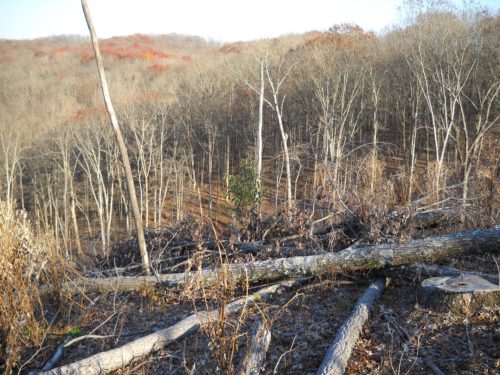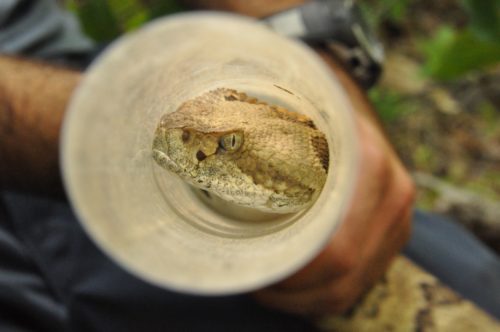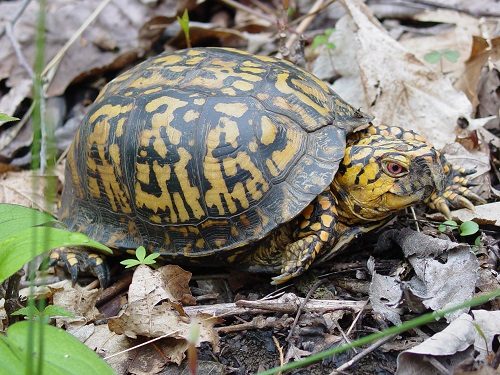 Purdue University - Extension - Forestry and Natural Resources
Purdue University - Extension - Forestry and Natural Resources
Got Nature? Blog
 There has been much debate in the popular press lately regarding the role of timber harvesting on forest communities. A common focus of this debate is the perceived impacts to wildlife. Most believe that leaving our forests alone is best for wildlife. However, to provide habitat for all of our native forest wildlife species, forests need to be diverse in terms of age, species and area. Harvesting timber is the primary means of achieving this structural diversity. The purpose of this article is to summarize some key points regarding the effects of harvesting on reptiles and amphibians. These points are drawn mostly from the Hardwood Ecosystem Experiment (HEE), an ongoing research study in southern Indiana. Its primary focus is to study forest management and its effects on plants and animals. A more detailed summary may be found in Forest Management for Reptiles and Amphibians.
There has been much debate in the popular press lately regarding the role of timber harvesting on forest communities. A common focus of this debate is the perceived impacts to wildlife. Most believe that leaving our forests alone is best for wildlife. However, to provide habitat for all of our native forest wildlife species, forests need to be diverse in terms of age, species and area. Harvesting timber is the primary means of achieving this structural diversity. The purpose of this article is to summarize some key points regarding the effects of harvesting on reptiles and amphibians. These points are drawn mostly from the Hardwood Ecosystem Experiment (HEE), an ongoing research study in southern Indiana. Its primary focus is to study forest management and its effects on plants and animals. A more detailed summary may be found in Forest Management for Reptiles and Amphibians.
There has been several large-scale studies that have investigated the effects of tree canopy removal on amphibians and reptiles. These include the HEE in Indiana, the Missouri Ozark Forest Ecosystem Project (MOFEP), and the Land-use Effects on Amphibian Populations (LEAP). Much of the work from these projects has been published in the scientific literature. All of these studies demonstrate that the response of amphibians and reptiles to timber harvesting is variable—it cannot simply be quantified as good or bad. Indeed, avoiding negative impacts to all reptiles and amphibians as a result of timber harvesting is neither possible nor desirable since disturbance-dependent wildlife species1,2 and many mature forest species3, require early successional forests.
Timber Rattlesnake
 For the focal species studied on the HEE, most exhibited moderate or no response in 1-3 years following timber harvests. The focal species I and colleagues have studied were timber rattlesnakes (Crotalus horridus), eastern box turtles (Terrapene carolina), and terrestrial salamanders. Timber harvests had no effect on the area male or female adult timber rattlesnakes used during the active season. There was no evidence that snakes changed movement behaviors to avoid clearcuts4. Indeed, several snakes were observed within clearcuts for several weeks and across multiple years. Annual survival of rattlesnakes on the HEE sites was high during the active season (72-98%) and winter (97-99%). Timber harvesting had no impact on survival. Declines in female survival was most affected by declines in prey abundance the previous year which were due to tree mast failures5. The level of acorns and nuts (i.e., mast) produced in woodlands naturally vary from year to year. When the small mammal population declined due to mast failure, these snakes were apparently impacted the following year.
For the focal species studied on the HEE, most exhibited moderate or no response in 1-3 years following timber harvests. The focal species I and colleagues have studied were timber rattlesnakes (Crotalus horridus), eastern box turtles (Terrapene carolina), and terrestrial salamanders. Timber harvests had no effect on the area male or female adult timber rattlesnakes used during the active season. There was no evidence that snakes changed movement behaviors to avoid clearcuts4. Indeed, several snakes were observed within clearcuts for several weeks and across multiple years. Annual survival of rattlesnakes on the HEE sites was high during the active season (72-98%) and winter (97-99%). Timber harvesting had no impact on survival. Declines in female survival was most affected by declines in prey abundance the previous year which were due to tree mast failures5. The level of acorns and nuts (i.e., mast) produced in woodlands naturally vary from year to year. When the small mammal population declined due to mast failure, these snakes were apparently impacted the following year.
Eastern Box Turtle
 For box turtles, there was no effect of timber harvests on home-range size, but the average daily distance traveled by turtles decreased by 30 percent following harvest, and turtles maintained 9 percent higher body temperatures6. Temperatures in harvest openings were 29 percent warmer in the summer and 31 percent colder in the winter than forested sites. Despite this change, turtles continued to use harvest openings during the active season, but tended to make shorter, more frequent movements in and out of harvests. Turtles likely used harvest edges for cover, thermoregulation and, possibly, foraging opportunities6. Harvested areas offered potential hibernation sites based on soil profile temperatures, slope aspect and depth of hibernation7. Both active and hibernal data suggest the level of harvesting on the HEE has modest effects on box turtle behavior, at least in the short term. To date, there is no evidence to support whether these changes have any impact—positive or negative—on box turtles.
For box turtles, there was no effect of timber harvests on home-range size, but the average daily distance traveled by turtles decreased by 30 percent following harvest, and turtles maintained 9 percent higher body temperatures6. Temperatures in harvest openings were 29 percent warmer in the summer and 31 percent colder in the winter than forested sites. Despite this change, turtles continued to use harvest openings during the active season, but tended to make shorter, more frequent movements in and out of harvests. Turtles likely used harvest edges for cover, thermoregulation and, possibly, foraging opportunities6. Harvested areas offered potential hibernation sites based on soil profile temperatures, slope aspect and depth of hibernation7. Both active and hibernal data suggest the level of harvesting on the HEE has modest effects on box turtle behavior, at least in the short term. To date, there is no evidence to support whether these changes have any impact—positive or negative—on box turtles.
Woodland Salamanders
 The response of woodland salamanders to harvests was species-specific8. The relative abundance of eastern red-backed salamanders (Plethodon cinereus) and northern slimy salamanders (Plethodon glutinosus) declined from pre- to post-harvest in patch cuts (1 to 3 acres) and clearcuts (10 acres). Red-backed salamanders also declined in control sites, suggesting factors other than the harvests contributed to salamander declines over the study period. However, red-backed salamander declines observed in control sites were not as severe as those seen within patch cuts and clearcuts, indicating harvests were at least partially responsible for observed declines within the harvest boundaries. The relative abundance of northern zigzag salamanders (Plethodon dorsalis) did not decline from pre- to post-harvest in any harvest type, and increased on sites adjacent to clearcuts.
The response of woodland salamanders to harvests was species-specific8. The relative abundance of eastern red-backed salamanders (Plethodon cinereus) and northern slimy salamanders (Plethodon glutinosus) declined from pre- to post-harvest in patch cuts (1 to 3 acres) and clearcuts (10 acres). Red-backed salamanders also declined in control sites, suggesting factors other than the harvests contributed to salamander declines over the study period. However, red-backed salamander declines observed in control sites were not as severe as those seen within patch cuts and clearcuts, indicating harvests were at least partially responsible for observed declines within the harvest boundaries. The relative abundance of northern zigzag salamanders (Plethodon dorsalis) did not decline from pre- to post-harvest in any harvest type, and increased on sites adjacent to clearcuts.- These findings suggest canopy removal (2-10 acre gaps) has short-term local impacts on terrestrial salamanders in terms of relative abundance, but effects do not necessarily extend to the adjacent forest matrix. A caveat to these findings is that the ultimate fate of displaced individuals remains unknown. That is, changes in relative abundance does not mean declines in survival. Indeed, sites adjacent to clearcuts experienced an increase in counts of zigzag salamanders, which could reflect the evacuation of individuals from the clearcut into the intact forest. It is also important to note that other factors influence the abundance of terrestrial salamanders. For example, in addition to differences between seasons (spring versus fall), drought played a significant role in declines in salamander abundance across all study area.
Forest management sometimes leads to short-term loses for some species but is critical to the long-term sustainability of many other species. Looking at the responses of just a few species, within cutover areas for a few years paints an incomplete picture. A large-scale, long-term perspective is necessary when considering forest management. This is the true value of well-designed studies such as the HEE. With experimental control and replication, researchers can untangle the story on what are the true effects of forest management over a large area over many decades. The HEE has shed light on many answers so far. We can look forward towards many more to come.
Resources
Wildlife Responses to Timber Harvesting, Video-The Education Store-Purdue Extension Resource Center
Hardwood Ecosystem Experiment – Forest Birds, Video-The Education Store
Managing Woodlands for Birds, Video-The Education Store
Sustaining Our Oak-Hickory Forests, Video-The Education Store
Breeding Birds and Forest Management: the Hardwood Ecosystem Experiment and the Central Hardwoods Region, The Education Store
Forest Management for Reptiles and Amphibians: A Technical Guide for the Midwest, The Education Store
Hardwood Ecosystem Experiment (HEE)
Brian MacGowan, Extension Wildlife Specialist
Department of Forestry & Natural Resources, Purdue University
Citations
1 Thompson, F. R., III, and D. R Dessecker. 1997. Management of early-successional communities in central hardwood forests: with special emphasis on the ecology and management of oaks, ruffed grouse, and forest songbirds. U.S. Forest Service General Technical Report NC-195, St. Paul, MN, USA.
2 Greenberg, C. H., B. Collins, F. R. Thompson, III, and McNab, W. H. 2011. “What are early successional habitats, why are they important, and how can they be sustained?” Pages 1-10 in Sustaining young forest communities: ecology and management of early successional habitats in the Central Hardwood Region, USA. C. H. Greenberg, B. Collins, and F. R. Thompson, III., editors. Springer, New York, NY, USA.
3 Chandler, C. C., D. I. King, and R. B. Chandler. 2012. Do mature birds prefer early-successional habitat during the post-fledging period? Forest Ecology and Management 264:1-9.
4 MacGowan, B.J., Currylow, A.F.T., and MacNeil, J.E. 2017. Short-term responses of Timber Rattlesnakes (Crotalus horridus) to even-aged timber harvests in Indiana. Forest Ecology and Management 387(1):30-36.
5 Olson, Z.H., B.J. MacGowan, M.T. Hamilton, A.F.T. Currylow, and R.N. Williams. 2015. Survival of timber rattlesnakes: Investigating individual, environmental, and ecological effects. Herpetologica 71:274-279.
6 Currylow, A.F., B.J. MacGowan, and R.N. Williams. 2012a. Hibernal thermal ecology of eastern box turtles within a managed forest landscape. Journal of Wildlife Management 77(2):326-335.
7 Currylow, A.F., B.J. MacGowan, and R.N. Williams. 2012b. Short-term forest management effects on a long-lived ectotherm. PLoS ONE 7(7):e40473.
8 MacNeil, J.E. and R.N.Williams. 2014. Effects of timber harvests and silvicultural edges on terrestrial salamanders. PLoS ONE, 9(12):e114683.

Recent Posts
- Top 10 Spring Flowering Shrubs, Purdue Landscape Report
Posted: April 28, 2025 in Gardening, Plants, Urban Forestry - HTIRC Continues to Protect Our Hardwood Forests
Posted: April 18, 2025 in Forestry, Timber Marketing, Woodlands - Tips to Manage Storm-Damaged Trees, Purdue Landscape Report
Posted: April 17, 2025 in Forests and Street Trees, How To, Urban Forestry - Liz Jackson Receives IHLA’s President’s Award, Featured in ANR Newsletter
Posted: in Forestry, Timber Marketing, Wildlife, Wood Products/Manufacturing, Woodlands - A Woodland Management Moment: Bottomland Forests
Posted: in Forests and Street Trees, Urban Forestry, Wildlife, Woodland Management Moment, Woodlands - When is the Peak Migration For Hummingbirds and How Can You Attract Them?
Posted: April 4, 2025 in How To, Wildlife - Smooth Patch of Oak – Purdue Landscape Report
Posted: March 27, 2025 in Forests and Street Trees, Urban Forestry, Wildlife, Woodlands - Prepared for Insects Waking Up? – PLR
Posted: March 26, 2025 in Forestry, Invasive Insects, Urban Forestry, Wildlife - ID That Tree: Invasive Autumn Olive
Posted: March 24, 2025 in Forestry, Invasive Plant Species, Urban Forestry, Wildlife, Woodlands - PPDL’s 2024 Annual Report – Enhancing Plant Health
Posted: March 21, 2025 in Forestry, Invasive Insects, Invasive Plant Species, Plants, Wildlife
Archives
Categories
- Alert
- Aquaculture/Fish
- Aquatic/Aquaculture Resources
- Ask the Expert
- Christmas Trees
- Community Development
- Disease
- Drought
- Forestry
- Forests and Street Trees
- Gardening
- Got Nature for Kids
- Great Lakes
- How To
- Invasive Animal Species
- Invasive Insects
- Invasive Plant Species
- Land Use
- Natural Resource Planning
- Nature of Teaching
- Plants
- Podcasts
- Ponds
- Publication
- Safety
- Spiders
- Timber Marketing
- Uncategorized
- Urban Forestry
- Webinar
- Wildlife
- Wood Products/Manufacturing
- Woodland Management Moment
- Woodlands